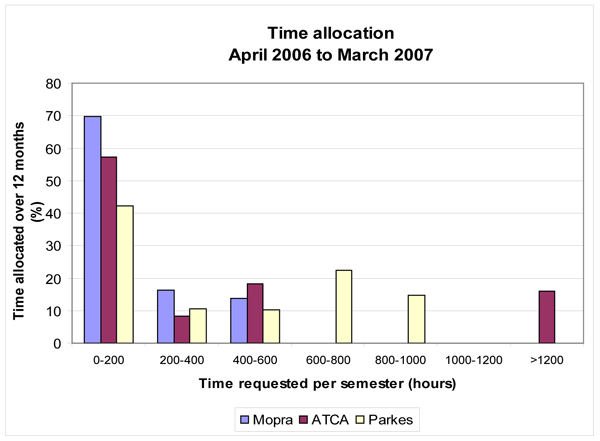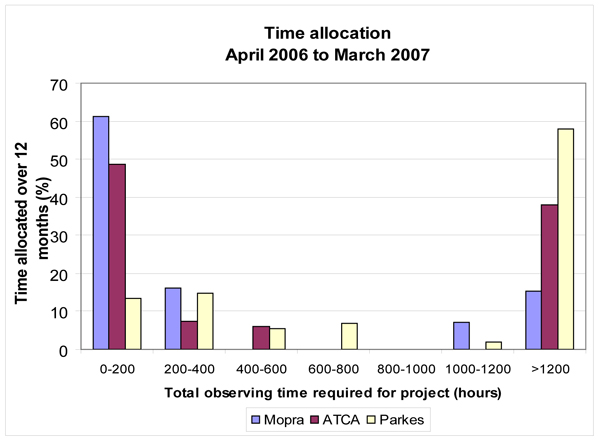Time assignment information
Compact Array 7-mm installation
The new 7-mm receivers will be installed on the Compact Array antennas during the four-week shutdown starting on 26 March. A number of larger maintenance jobs on the antennas, such as UPS replacement and work on antenna drives, will also be undertaken during this period. Ilana Klamer has written new webpages for the 7-mm systems, which are available at www.atnf.csiro.au/observers/docs/7mm/.
NASA tracking
Development of the new 7-mm receivers has been co-funded by NASA-JPL as a frequency of 32 GHz is being increasingly adopted for planetary missions. Following the installation and characterisation of the 7-mm receivers, the Compact Array will undertake a number of tracking demonstration and proficiency tests in readiness for use of the array as a NASA downlink station. The formal operations phase agreement between NASA and CSIRO is not yet finalised, but the understanding is that the array will be used, on average, for around 10 hours per week for tracking, with occasional periods of up to 50 hours per week. These will be included in the regular Compact Array scheduling process and appear in the Compact Array schedule as "NASA Tracking" blocks. There will also be provision for NASA to request use of the array at short notice for emergencies, which, should they arise, will have an impact on scheduled observations. As with any target-of-opportunity type observation, where possible, observations displaced by such an emergency will be rescheduled.
Observation tables
Part of the proposal process for the use of ATNF telescopes is the completion of an observations table. For the Compact Array and Mopra, this table has two uses: first, for the Time Assignment Committee (TAC) to see which sources will be observed, at which frequencies, and for how long, and second, to feed into the Compact Array and Mopra scheduling tool. Unfortunately, these two uses are not always complementary. Whereas the TAC will certainly be interested to learn you wish to observe 300 sources with a one minute integration on each, this information feeds into the scheduling tool as a request for 300 one-minute slots! So, to help your poor scheduler, it is extremely useful to have a statement in the proposal of exactly how you would like your observations scheduled, such as "four blocks of six hours duration scheduled anywhere between 07:30 and 15:30 LST." Such clear statements indicate to the TAC that you have carefully thought about the scheduling of your proposed observations, and make the scheduler's life significantly easier!
Large projects
The TAC has recently considered the submission of projects that require large amounts of observing time on the telescopes. Here we discuss recent time allocation statistics for the Compact Array, the Parkes radio telescope and the Mopra radio telescope, and we advise users of some changes to the proposal submission requirements for large projects on all ATNF facilities.
Time allocation statistics
Figures 1 and 2 show some time allocation statistics for the period from April 2006 to March 2007, corresponding to the two most recent semesters. Figure 1 shows the fraction of the total telescope time allocated plotted against time requested on the submitted proposals. For the Compact Array, 57% of time was allocated to proposals that requested up to 200 hours of observing time while 34% of time was allocated to all proposals that requested 400 hours or more. For the Parkes telescope, 42% of time was allocated to the proposals that requested up to 200 hours, with 47% allocated to proposals requesting 400 hours or more. For Mopra, 70% of time was allocated to proposals that requested less than 200 hours while 14% was allocated to proposals requesting 400 hours or more.

Figure 1: The percentage time allocated to Compact Array and Parkes proposals submitted between April 2006 and March 2007, plotted against the time requested on the proposals.

Figure 2: The percentage time allocated to Compact Array and Parkes proposals submitted between April 2006 and March 2007, plotted against the total time required for the projects.
As a working definition, we define a large project as one which will require a total time allocation of 400 hours or more. For the Compact Array, eight of the 156 projects allocated time between April 2006 and March 2007 are included in this category, while for Parkes there were 13 of the 42 projects, and for Mopra there were four of the 40 projects.
Submission of proposals for large projects
We advise proposers that for the 2007 October observing semester (07OCTS) and onwards, all projects requesting a total of more than 400 hours of observing time on any ATNF telescope will fall into the category of large projects. For the initial proposal submission, large projects will have, in addition to the three-page limit for scientific justification, an additional two pages to be used for defining mandatory data analysis and timeline plans, data release plans, and a recommended public outreach plan. Additional figures supporting the scientific justification can be included within the two additional pages if desired.
Large projects can request time be allocated over several semesters, and if successful will usually be given continuing status to reflect this. A progress report (up to three pages) will then be required before further time is allocated. The TAC may choose to award reduced time allocations in cases where a small pilot study is required to show success before a large project can be judged on its scientific and technical merits.
For the ATNF there is no particular fraction of telescope time mandated for large projects. All proposals are judged and awarded time based on scientific merit. Proprietary periods for large projects are the same as for other projects, but early data release plans and waivers of proprietary periods are looked upon favourably.
Please note that unless already advised otherwise, proposals submitted for the 2007 April Observing Semester (07APRS) do not have continuing status. For information on submitting proposals for large projects please see the web page www.atnf.csiro.au/observers/apply/large_projects.html.
Jessica Chapman, Phil Edwards and David McConnell (ATNF), Andrew Hopkins (University of Sydney), John Dickey (University of Tasmania)
(Jessica.Chapman@csiro.au)
